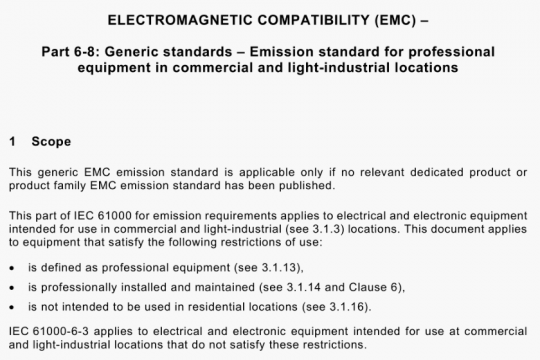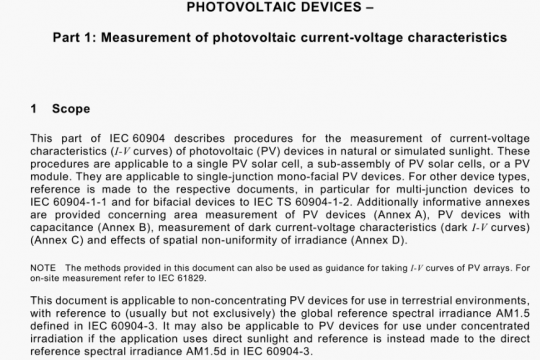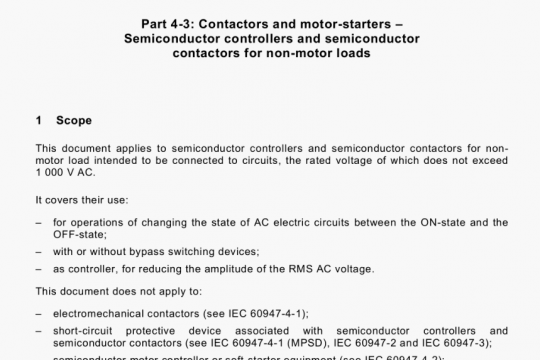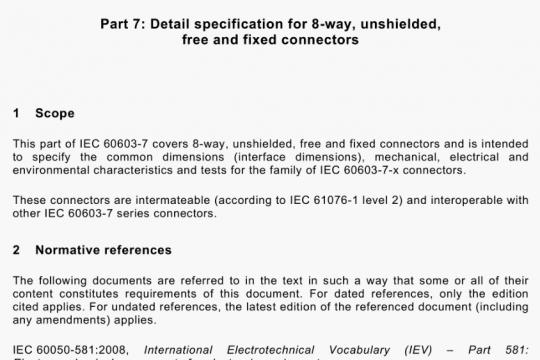IEC 60664-1-2020 pdf free
IEC 60664-1-2020 pdf free.Insulation coordination for equipment within low-voltage supply systems – Part 1: Principles, requirements and tests.
4 Basic technical characteristics for insulation coordination
4.1 General
Insulation coordination requires the selection of the electric insulation technical characteristics of the equipment with regard to its application and in relation to its surroundings and environmental conditions.
Insulation coordination represents one aspect of the safety of persons, livestock and property, so that the probability of risk of incidents due to voltage stresses does not lead to an unacceptable risk of harm.
This document addresses insulation coordination for any kind of hazard. Technical committees shall take Into account the concepts of clearance, creepage distance and solid insulation as well as the concepts of functional insulation, basic insulation, supplementary Insulation, double Insulation and reinforced Insulation for the specific hazard considering the nature of the hazard.
The technical committee shall make a risk assessment to identify the hazard in case of fault of functional Insulation. In case a failure of functional Insulation could create an unacceptable risk of harm (for example, due to mechanical conditions, ageing behaviour), functional insulation shall at a minimum be designed according to the requirements of basic Insulation, after which another risk assessment is performed to assess the residual risk, See 5.2 to 5.4. In case a fault of functional Insulation does not create any hazard, the technical committee may choose not to apply the requirements of this basic safety publication.
NOTE See ISOIIEC Guide 51 and IEC Guide 116 for further details about risk assessment and unacceptable risk
of harm.
Electric insulation technical characteristics cover:
— voltages across the insulation according to 4.2:
— overvoltage categories according to 4.3;
— frequency according to 4.4;
— pollution degree according to 4.5;
— insulation materials according to 4.6;
— environmental aspects according to 4.7 (e.g. altitude see 4.7.2, temperature see 4.7.3, vibrations see 4.7.4, humidity see 4.7.5, duration see 4.8):
— field distribution according to 4.9.
Insulation coordination can only be achieved if the design of the equipment is based on the stresses to which it is likely to be subjected during its intended life.
4.2 Voltages
4.2.1 General aspects
When considering insulation performances, the following aspects are relevant:
— the voltages which can appear within the system:
• transient overvoltages according to 4.2.2 and overvoltage category according to 4.3;
• temporary overvoltages according to 4.2.3.
— the voltages generated by the equipment (which could adversely affect other equipment in the system):
• transient overvoltage according to 4.2.2;
• recurring peak voltage according to 4.2.4;
4.2.2 Transient overvoltages
4.2.2.1 General
To apply the concept of Insulation coordination, transient overvoltage shall be taken into consideration. The transient overvoltages that shall be considered are:
– transient overvoltages generated by atmospheric disturbances (for example indirect lightning strikes) and transmitted by the mains supply distribution system;
— transient overvoltages generated due to switching of loads in the mains supply:
— transient overvoltages generated by external circuits;
— transient overvoltages generated internally in the equipment.
Insulation coordination uses a preferred series of values of impulse voltages. The preferred
impulse voltages are:
330 V. 500 V. 800 V. 1 500 V. 2 500 V. 4 000 V. 6 000 V. 8 000 V. 12 000 V.
Insulation coordination with regard to transient overvoltage is based on controlled overvoltage conditions. There are two kinds of control:
— inherent control: the condition within an electrical system wherein the characteristics of the system can be expected to limit the prospective transient overvoltages to a defined level:
— protective control: the condition within an electrical system wherein specific overvoltage attenuating means can be expected to limit the prospective transient overvoltages to a defined level.
See also Table B.1 and Table B.2.
4.2.2.2 Transient overvoltages entering through the mains supply
To determine the expected transients generated by atmospheric disturbances or due to switching of loads in the mains supply, the rated voltage (Un) and the overvoltage category are normally used as the basis to determine the required impulse withstand voltage.
For equipment subjected to transient overvoltages that exceed the impulse withstand voltage these transient overvoltages shall be taken into account
4.2.2.3 Transient overvoltages generated by external circuits
The applicable value of the transient overvoltage that may occur on any external circuit (for example coaxial cable or twisted pair networks) shall be determined. Where more than one external circuit is present, the highest transient overvoltage applies.IEC 60664-1 pdf download.




